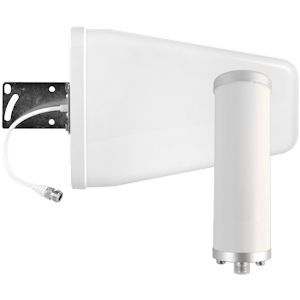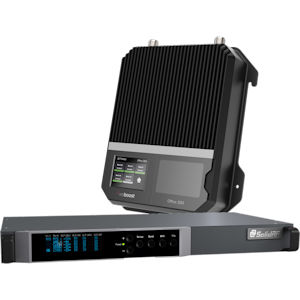Knowledge Base
How do I install a cell signal booster in my business?
Most commercial signal booster systems require the installation of four components:
 Outside antennas: LPDA (left) and omnidirectional (right)
Outside antennas: LPDA (left) and omnidirectional (right)
- Outside antenna. Powerful Signal recommends mounting this antenna on your roof. We include an adjustable roof antenna mount with many of our custom booster kits; you can also purchase one separately.
If the outside antenna is a directional antenna (an LPDA or Yagi), it’s best to have a direct line of sight to the cell tower, clear of any obstructions, for optimal performance. A directional antenna will need to be adjusted (tuned) until it’s receiving the strongest signal. (Learn how.)
Omnidirectional antennas do not require line-of-sight or tuning. They work best when you have fair-to-good outside cell signal and you need the booster to amplify two or more cellular carrier networks.
The outside antenna needs enough separation from the inside antenna so that the two antennas don’t feed back on each other (a condition called oscillation). We recommend that you have at least 20 vertical feet or 50 horizontal feet between the two antennas. The roofs of many businesses are thick enough to provide adequate shielding, reducing or eliminating the need for antenna separation.
 The weBoost Office 200 (top) is wall‑mounted. The Top Signal Fiber DAS 4400 (bottom) is rack‑mounted.
The weBoost Office 200 (top) is wall‑mounted. The Top Signal Fiber DAS 4400 (bottom) is rack‑mounted.
- Amplifier. The booster unit will normally be mounted on a wall inside your office. We recommend mounting it in your I.T. closet, a utility closet, or another location where it’s secure but you can still get to it. Mounting requires either two or four screws, depending on the booster model. Screws drilled into drywall should use anchors or toggle bolts
appropriate to the weight of the amplifier (typically less than 10 pounds).
Some commercial boosters are rack-mounted and will fit into a server rack alongside your network equipment.
The booster is plugged into a standard 120-volt wall outlet, so you’ll need to have an electrical outlet near the location where you mount the booster unit. You’ll also want to use a surge protectorwith at least a 1,000-Joule rating, as required by booster manufacturers’ warranties.
 Inside antennas: dome (left) and panel (right)
Inside antennas: dome (left) and panel (right)
- Inside antenna(s). Your cell signal booster kit will contain one to four inside antennas. These will either be ceiling-mounted dome antennas or wall-mounted panel antennas.
Installing a dome antenna requires that you have a drop ceiling or access above a hard deck ceiling. Mount the dome close to the center of the area where you need improved cell signal. Cut a hole in the ceiling large enough for the antenna’s mounting post (about ¾-inch or 6.4 mm in diameter), then screw the nylon nut onto the threads on the mounting post above the ceiling and attach the cable.
Installing a wall-mounted panel antenna can be simple or complicated, depending on if you want the antenna and/or its cable to be concealed inside the wall. Simply hanging the antenna on the wall is quick and easy; cutting a hole in the wall, mounting it inside, covering the hole with drywall, and patching and painting the seam require more planning.
 400‑type coax cable with an N‑male connector)
400‑type coax cable with an N‑male connector)
- Coax cables. The amplifier connects to the outside antenna and inside antenna(s) with coax cable. Running cable is fairly straightforward if you have cable trays, conduit, or other spaces for electrical and network cables. Panel antennas may require fishing cable through drywall.
50-ohm commercial cellular boosters typically use 400-type coax cable. 400 coax is 3⁄8 inches (10.2 mm) in diameter, with 7⁄8-inch (23 mm) N connectors at each end.
75-ohm commercial boosters typically use similarly-sized RG11 coax cable with F connectors.
For best performance, use the shortest run of cable possible to the outside antenna. If you have excess cable in a run to an outside or inside antenna, snake it back and forth or run it out and back, but do not coil it.
If you’d prefer to have your commercial signal booster installed in your business, please click here to get a quote on a custom solution. We also offer the weBoost Office 300 Installed, which can cover indoor spaces up to 15,000 square feet and includes professional installation.

